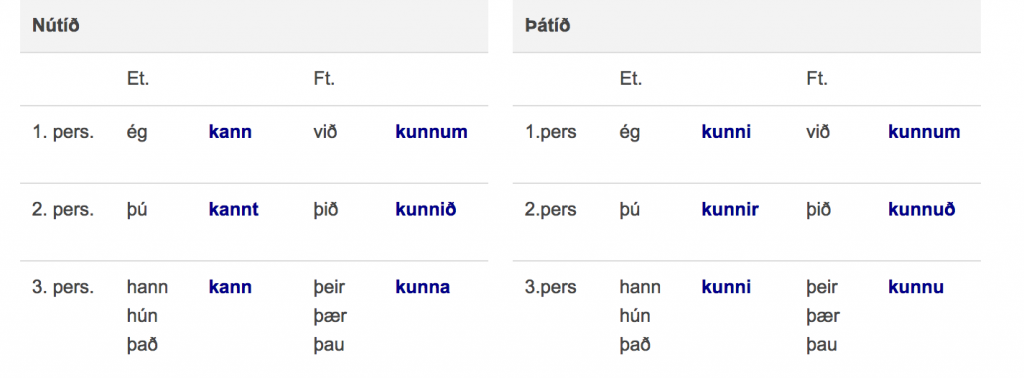I Know How To Do It, But Not How To Say It: Helping Verbs 101 Posted by Meg on Jun 14, 2017 in Icelandic grammar
Today, I’d like to cover a few auxiliary verbs that I consider to be indispensable tools to have in your Icelandic repertoire. All of the verbs in this entry symbolize, in some way, a knowledge of something. They range from ability (hæfni) to aptitude (hæfileiki) to knowledge (kunnátta) to facts (staðreynd) to mere familiarity or acquaintance (þekking).
First though, an auxiliary verb is essentially a verb that adds function to the sentence (or clause) in which it appears. In the title of this blog post, I know how to do it, the auxiliary verb is “to know.” And, of course, if you have something that’s auxiliary, it means there has to be something that’s primary. The point of the sentence I know how to do it is “to do,” so that’s your main verb; “to know” allows the sentence to express a complete idea.
So the auxiliary verb is a helper, and is also called a helping verb (Icelandic: “hjálparsögn” or “hjálparsagnorð”). The main verb in Icelandic is called the “aðalsögn.”
Geta – to be able to, can
Geta is almost always accompanied by a second verb, just like in English (unless you’re simply saying “I can”). The “main verb” that would be used with geta is in the neuter past participle form (e.g., gera = gert, lesa = lesið, fara = farið, tala = talað). The neuter past participle form is listed in the kennimynd in the dictionary (detailed below). Ég get gert það, means that you can do it. Letidýrið getur talað means “the sloth can talk.” Það getur líka flogið! (It can also fly!). Ég get hjálpað þér ef þú vilt (I can help you, if you want). Often, if you know the verb type (weak/strong, and which class of weak/strong), you can work out what the participle might be.
How To Use The Kennimynd
Kennimynd
The kennimynd of a verb means “principle parts,” i.e., those that are crucial to the declension of the verb. It’s listed in the dictionary immediately after the entry. Here are a version of how it might appear:
Irregular or strong verb:
fara (v acc): fer; fór, fóru, farið
(1) first person present tense (ég)
(2) first person past tense (ég)
(3) third person plural past tense (þeir, þær, þau)
(4) past participle
Strong-ish (weak type 2, etc.):
gera (v acc): gerir; gerði, gert
(1) Second person singular present tense (þú)
(2) First person singular past tense (ég)
(3) Past participle
If the verb is totally normal – a weak type 1 – it’ll just list –aði, which is a boon. It’s participle will simply be the verb + ð.
tal/a (v) -aði
Kunna –To know how to do something.
IT DOES NOT MEAN “CAN”. BEWARE THE FALSE COGNATE!!Kunna is used in two ways – it can be used both as a helping verb and as a main verb. If it’s a helping verb, it’s just like saying “I know how to ride a bicycle,” (ég kann að hjóla) or “I know how to cook” (ég kann að elda) without using the word “how”. If it’s a main verb, it means “I know Icelandic,” (ég kann íslensku) “I know the poem by heart” (Ég kann ljóðið utan að). As you can see, its “main verb” is in the infinitive, not the past participle, form. The noun kunnátta – meaning knowledge, skill – is the noun form of the verb kunna.

Vita – to know a fact
Vita is used when you know something for a fact. In general, an entire clause or sentence will follow after it, or simply the word “það.” There’s no uncertainty here.
Við vitum að sýningin byrjar klukkan níu. | We know that the show begins at 9. Hann er giftur. Ég veit það. | He is married. I know that. Ég veit hvar húsið hans er.| I know where his house is. Veist þú hvort hann heitir Úlfar eða Úlfur? | Do you know if his name is Úlfar or Úlfur?
Þekkja – to know of/to know a person
Þekkja is used when you´re talking about people (I know her) and when you’re talking about something that you have knowledge of because you’ve seen or heard it. The predicate is always in accusative when you use this verb. Here are a few examples.
Ég þekki allt fólkið í húsinu | I know everyone in the house/building.
Ég þekki lagið en kann það samt ekki. | (approx.) I’ve heard the song, but I don’t know it.
Hún þekkir þessa bók. | She knows the book.
Hún þekkti mig aftur. | She recognized me.
* Við þekktumst áður fyrr. | We knew each other a long time ago.
*This last example is mediopassive voice. It’s used, in this case, to apply simultaneity – mutual knowledge of each other. A common example is við sjáumst, or við heyrumst, roughly equivalent to “see you” or “we’ll see each other,” and “we’ll be in touch,” “talk soon.”
Kannast við
Síðast en ekki síst – last, but not least – we have kannast við. To start off, kannast við always takes the accusative. It has a similiar meaning to þekkja, to know of, but is slightly weaker. For example, if you´re talking about a guy named Pétur who you recently met, but aren´t close to (an acquiantance), you’d say:
Or, imagine you’re at your friend’s house and they’ve found a scarf. They turn to you to ask if you’ve ever seen this lost scarf before in your life. The conversation might go like this:
Kannast þú nokkuð við þennan trefil?
You recognize this scarf?/Don’t you recognize this scarf?
Jú, ég hef séð hann áður en ég man ekki hver á hann.
Yes, I’ve seen it before, but I have no idea who owns it.
Those are just a few examples of auxiliary verbs that imply a degree of knowledge. This isn’t an exhaustive list of helping verbs, and we haven’t even covered the use of “hafa,” but it’ll get you started. Here’s this week’s video to help you practice listening. Let me know how it goes! (Hint: it’s a pun on rekinn – to be fired and drekinn – the dragon).

Build vocabulary, practice pronunciation, and more with Transparent Language Online. Available anytime, anywhere, on any device.





